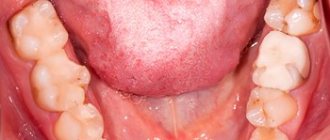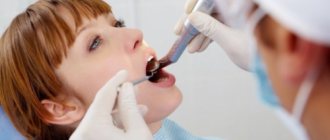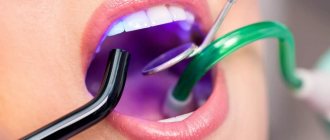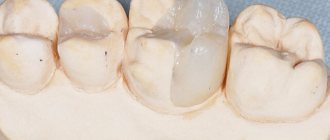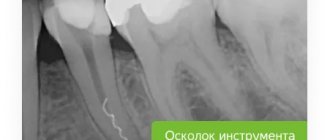Author of the article:
Soldatova Lyudmila Nikolaevna
Candidate of Medical Sciences, Professor of the Department of Clinical Dentistry of the St. Petersburg Medical and Social Institute, Chief Physician of the Alfa-Dent Dental Clinic, St. Petersburg
Expecting relief from pain from going to the dentist, patients sometimes leave the office confused - why hasn’t the pain completely gone away? It can be present for several hours or last much longer.
Why does a tooth hurt after filling?
The filling that the doctor places on the treated tooth should exclude the possibility of disease. If you feel pain after filling, the reason may be:
- The body's natural reaction to outside interference. Even after proper treatment, such a phenomenon may occur, which is periodic in nature. The pain in this case does not increase or become too severe; it can last from 2 weeks to 2 months.
- Caries is not completely cured. The tooth tissues become inflamed, and the tooth hurts after filling with aching pain. In this case, it is necessary to contact the dentist again to prevent further complications - inflammation can affect the dental nerve (pulpitis develops).
- Chronic or developing pulpitis that was not identified during the diagnostic process before the start of treatment.
- Incomplete treatment of tissues affected by inflammation during periodontitis. Treatment of periodontitis is not limited to one day, it is quite complex.
- If the filling is installed incorrectly (either at an insufficient level, or is large and puts pressure on other teeth or gums). Often a tooth hurts after root canal filling for this very reason. Damage to the filling can occur due to insufficiently high quality filling material or failure to comply with the recommendations of the dentist.
- Slight pain may be felt due to tissue injury during the process of tooth filling. It will take some time for healing to occur.
- The sensitivity of teeth after filling always increases significantly, and discomfort, manifested in painful sensations, can be the result of insufficiently correct implementation of one of the treatment procedures - drying the inner dental walls (over-drying or under-drying). If the walls of the tooth are not completely dry when installing the filling, it does not adhere well in damp places, which leads to the development of inflammation and pain.
- Allergic reaction to the filling material.
It is much easier to identify pathologies after dental treatment if all the dentist’s advice and oral hygiene rules are followed.
Attention! Dentists recommend that their patients have a small snack before going to the dental office, so that due to the lack of glucose that occurs during treatment, fear and the vasoconstrictive effect of the drugs, they do not experience a semi-fainting state during the treatment.
How long after filling should I abstain from eating?
Modern fillings contain epoxy resin, which ensures that the new filling quickly hardens into the desired shape. Light-polymer fillings harden almost instantly, while those made from chemical materials take no more than an hour. Therefore, after filling a tooth, you can eat food immediately.
When installing a temporary filling, a longer period of time abstaining from eating is required - at least 2 hours.
Toothache during pregnancy: what to do
So, what can you do to relieve pain if your tooth hurts during pregnancy... Remember that even approved medications should be taken by pregnant women only after consulting a doctor.
- Nurofen 200 mg or 400 mg (Fig. 7-8) - it can only be used in the 1-2 trimesters, but not in the 3rd trimester. Nurofen is available in dosages of 200 and 400 mg. Pregnant women can use both dosages. But we recommend that if the pain is not very severe, use a dosage of 200 mg (no more than 4 tablets per day). If the pain is very severe, then the dosage is 400 mg, but not more than 3 tablets per day.
- Paracetamol 500 mg - can be used throughout pregnancy, preferably only after consulting a doctor. No more than 2 tablets per day.
Important: you must understand that analgesics are only a temporary solution to the problem. If you have a toothache, you will still need to see a doctor. There are periods of dental treatment for pregnant women, during which dental treatment is quite safe for both the mother and the unborn child.
My gums hurt after filling a tooth, what should I do?
If, after installing a filling, your gums are very sore and even your cheek is swollen, you cannot do without the help of a dentist. Moreover, it is necessary to contact as soon as possible so that there are no even more unpleasant consequences.
A few tips to relieve pain:
- applying an ice compress to the cheek at the sore spot for several minutes or a compress with ice cubes;
- alternate application of compresses with warm rinses from decoctions of medicinal herbs or infusions;
- painkillers;
- balms to strengthen teeth and gums.
Attention! Under no circumstances should you apply hot or warm compresses - they actively provoke inflammation and pain!
Taking antibiotics without a doctor's prescription is also extremely contraindicated, because this can lead to a decrease in immunity and complicate further treatment.
Preventive measures
After filling a tooth, during the first week, you must strictly follow the main rules so that pain does not occur, or it disappears as soon as possible:
- do not drink or eat too cold or too hot, as temperature changes provoke pain;
- every time after eating, brush your teeth and rinse your mouth with special anesthetic rinses (the ASEPTA series includes rinses with an analgesic and disinfecting effect);
- try to eat softer foods so as not to damage the periodontal tissues, and it is preferable to chew only on the healthy side;
- do not smoke, as the tooth disturbed by treatment is very sensitive in the first days.
What to do if a child has a toothache -
If a child has a toothache, how to numb the pain will depend on his age. In children over 6 years of age, it is optimal to use the drug Nurofen 200 mg (contains the NSAID ibuprofen), which is approved from 6 years of age. This drug will not only help relieve severe pain, but also has an anti-inflammatory effect (Fig. 9).
In children aged 3 months and older, it is also optimal to use an NSAID-based analgesic, for example, children's Nurofen in suppositories for the youngest, and in suspension for older children (Fig. 10-11). The package of Nurofen Baby suspension contains a special dispenser that helps measure the required amount of the drug, as well as a diagram that helps to calculate the volume of the drug depending on the child’s body weight.
In addition to Nurofen, from 2-3 months, a child can also use paracetamol-based analgesics, for example, children's Panadol in the form of a suspension (Fig. 12). Each 5 ml of suspension contains 120 mg of paracetamol.
The volume of suspension/dose of paracetamol will depend on the age (body weight of the child). The drug is taken 3-4 times a day, single doses of the drug in “ml” and “mg” depend on the age of the child - are indicated in Table 1. The permitted dose of paracetamol depending on the child’s body weight is -
| Body weight (kg) | Age | Paracetamol dose | |||
| One-time | Maximum daily | ||||
| ml | mg | ml | mg | ||
| 4,5-6 | 2nd month of life | Only on doctor's orders | |||
| 6-8 | 3-6 months | 4.0 | 96 | 16 | 384 |
| 8-10 | 6-12 months | 5.0 | 120 | 20 | 480 |
| 10-13 | 1-2 years | 7.0 | 168 | 28 | 672 |
| 13-15 | 2-3 years | 9.0 | 216 | 36 | 864 |
| 15-21 | 3-6 years | 10.0 | 240 | 40 | 960 |
| 21 -29 | 6-9 years | 14.0 | 336 | 56 | 1344 |
| 29-42 | 9-12 years | 20.0 | 480 | 80 | 1920 |
Experts' opinion
The effectiveness of the ASEPTA series products has been proven by multiple clinical trials conducted in the country's leading research institutes.
For example, a study of the clinical effectiveness of treatment and prophylactic agents from the Asepta line in the treatment of inflammatory periodontal diseases, conducted by A.I. Grudyanov, I.Yu. Alexandrovskaya, V.Yu. Korzunina in the Department of Periodontology of the Central Research Institute of Dentistry and Maxillofacial Surgery of Rosmedtekhnologii, Moscow, made it possible to identify the fairly high effectiveness of the Asepta gum balm and the Asepta mouth rinse for moderate periodontitis. The use of Asepta mouth rinse for inflammation also turned out to be quite effective. In addition, no phenomena of mucosal irritation or brown staining of fillings were recorded. This indicates that the use of this rinse for a two-week period provides an obvious clinical effect in the absence of negative side effects.
Should I see a doctor if I have pain after root canal cleaning?
Root canal cleaning is a surgical procedure that is performed when infection occurs and inflammation develops. Most often it is performed for pulpitis or periodontitis. This affects the soft tissues of the oral cavity. It should be borne in mind that in this case, already inflamed tissues are treated, and after cleaning, the inflammation persists for several days.
Therefore, a slight aching pain after therapy is normal and is not considered a cause for concern. At night, the pain often intensifies.
After a couple of days, the healing process enters an active phase, the pain slowly and gradually decreases, although pain and discomfort may persist for several weeks. They can be reduced or eliminated through anesthetic medications and rinses.
The pain syndrome can persist for a long time if the patient delays visiting the dentist, as a result of which the inflammation has become extensive and severe. Therefore, it is so important to regularly visit a specialist, undergo preventive examinations and visit a doctor at the first signs of illness. The sooner the problem is detected, the less complex and painful the therapy and rehabilitation will be.
Consumer Reviews
Mrs. Doubtfire about Asepta Active mouth rinse (irecommend.ru):
“When I was faced with a serious gum problem, this rinse was recommended to me by a dental surgeon.
Asepta Active mouthwash is a medical product and is sold only through the pharmacy chain. The instructions recommend taking breaks in use. Personally, I use it in courses and during exacerbations of gum inflammation. I've been using it for about 2 years.
The mouthwash is minty, pleasant, slightly astringent. Improvement is felt from the first use. Bottle volume 150 ml. Manufacturer: Russia, St. Petersburg. A convenient measuring cup is included.
You can (better) buy it as a set, which also includes balm and toothpaste, which comes as a gift.
I’m very happy that such products from a domestic manufacturer have appeared!”
julia-06 about Asepta Active mouth rinse (irecommend.ru):
“A very good rinse for problem gums.
She had never encountered the problem of bleeding gums, but at her next visit to the dentist she noticed that when she only lightly touched her gums, they began to bleed. So the dentist gave me a mini version of Paradontax toothpaste and advised me to use a mouthwash after brushing my teeth. Mom bought Asepta active mouth rinse.
For some reason I used to be very skeptical about such remedies, but as it turned out, in practice it helps very well. My problem went away completely, my gums stopped bleeding. I don’t even want to read the ingredients and go into its details, it’s unlikely that everything is super natural, but since it helps, I give the mouthwash a solid 5 points. Of course, each case is individual, but I will recommend it based on my experience. And the price of the rinse aid is quite reasonable.”
Why do patients experience pain after caries removal?
The Nurimed Clinic provides highly qualified treatment for dental caries, but even our specialists cannot promise the absence of pain after therapy, since much depends on the individual characteristics of each patient.
The main factors contributing to the occurrence of pain syndrome:
- Excessive drying of the tooth before placing a filling. Before completing caries treatment, the doctor etches the enamel with a special compound, which is then washed off and the dentin is dried. When the tissue is overexposed, its natural moisture is lost, which subsequently leads to pain.
- Insufficient tooth drying. Remaining moisture on the dentin leads to the fact that the filling is not fully and correctly attached. In such situations, it is very likely to be torn off, and the tooth will be disturbed under vertical loads (chewing).
- Relapse of the carious process. Caries is an infectious disease caused by pathogenic flora. Doctors are not always able to completely get rid of bacterial pathogens, which is why pain appears again some time after treatment.
- Complications after caries. Even after treatment, it cannot be guaranteed that the carious process has not reached the pulp or periodontium. The pain process can be triggered by an exacerbation of the inflammatory process in these areas.
- Incomplete removal of the neurovascular bundle (pulp). Even X-ray studies can give false information, so remnants of nerve endings cannot always be removed immediately. This is especially true for people with branchy and deep roots.
- Exit of the filling into the periapical area. A rare complication, since all procedures in modern dentistry are performed under radiographic control.
- Presence of air in the filling. The nerve endings are irritated, which causes pain. The problem arises when the filling installation technique is violated.
- Breakdown of instruments. In some cases, in patients with branched and deep roots, instruments break when extracting the pulp. If the debris has not been removed, then an inflammatory process gradually develops, which is accompanied by pain.
- Intolerance to the components of the filling or any other substances used in treatment. The pain syndrome in such cases is caused by severe swelling.
In addition to these common causes, pain can be caused by errors in treatment, in particular, irritation of the pulp by a specific acid used to etch the enamel.
Only a dentist can accurately answer the question of why pain occurs after caries treatment, so you should not put off visiting him.
How to cope with pain?
In the fight against pain, it is not recommended to use untested folk remedies, especially if alarming symptoms develop. If you are not sure whether your feelings are normal, make an appointment with your dentist or consult with him by telephone.
To eliminate pain, special medications prescribed by the doctor are suitable. These most often include drugs from the group of non-steroidal anti-inflammatory drugs, for example, Ibuprofen, Nise, Nimesulide and others.
The medications are taken strictly according to the instructions and recommendations of the dentist. Additionally, cold compresses can be used.
Following recommendations after caries treatment
The duration and general presence of pain depend on the correctness of the rehabilitation period and the implementation of the recommendations given by the doctor. These include:
- Smoking ban;
- Limiting foods with dyes;
- Limiting the consumption of foods that are too hot or too cold;
- Refusal from solid food during rehabilitation, requiring effort when biting (nuts, apples, etc.);
- Prohibition on the use of chewing gum;
- Limiting the consumption of sweets;
- Careful oral hygiene according to the algorithm that the dentist will tell you (do not over-clean your teeth with a hard brush).
Recommendations also include drug therapy, which includes painkillers, anti-inflammatory drugs, a course of antibiotics for the treatment of advanced lesions, antiseptic rinses and the application of special ointments.
